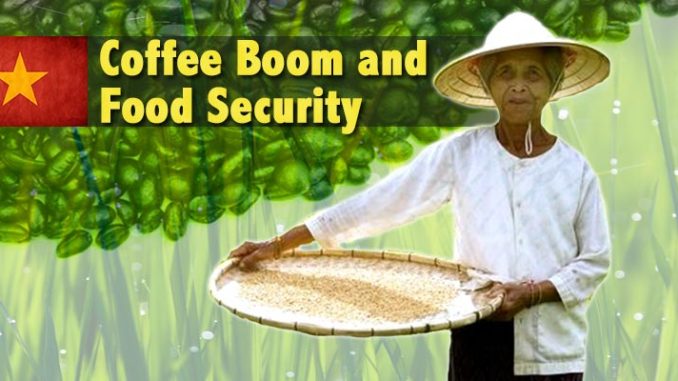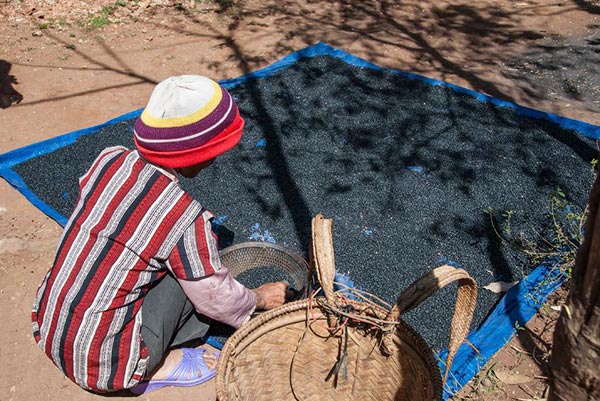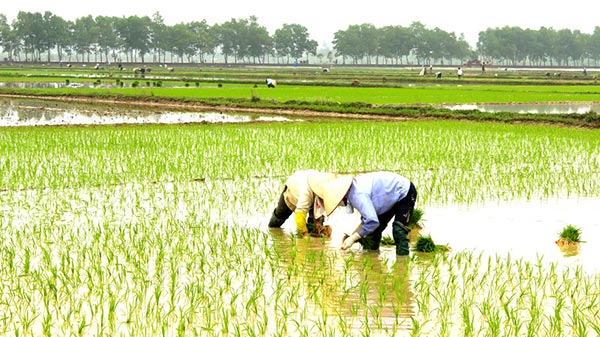
Today, coffee is currently one of the hottest boom crops in Vietnam. Coffee trees were first introduced to Vietnam at the end of the 19th century by French missionaries who established coffee plantations around churches in the provinces of Ha Nam, Quang Binh, and Kon Tum; however, it wasn’t until the early 20th century that coffee started to be grown on a large scale. Extensive plantations were first established in Phu Quy, Nghe An Province, and then later in the provinces of Dak Lak and Lam Dong, although at that time the total area of land under coffee plantation occupied only a few thousand hectares. After the August Revolution in 1945, state-own farms began expanding their coffee-growing operations in North Vietnam, reaching a peak of over 10,000 hectares (ha) in 1963–1964. Furthermore, by 1975 nearly 10,000 hectares of coffee trees had been planted in South Vietnam. During the war with America, coffee production completely ceased, but at the beginning of economic liberalization in 1986 (Doi Moi), private enterprises in the coffee industry were once again allowed to establish businesses. By 2000, Vietnam had become the world’s second largest exporter of coffee, and current estimates indicate that coffee plantations as large as 500 to 600 ha exist in many parts of the country.
The coffee boom has had a significant effect on farmers’ livelihoods as coffee plantations change both the status and structure of incomes as well as land use. Household income levels differ between those with and without coffee connections. Most commonly, incomes are related to cutting grass, harvesting, and drying coffee.

Changes in land use
As the coffee boom took hold, land use has become increasingly diverse. Rice hectarage has been reduced because most of the swidden land (land cleared for cultivation) has been converted for coffee growing. Furthermore, many households plan to use all of their available swidden land for the bean. Driven by the large demand for coffee land, land purchases have been promptly legitimized allowing landholders to grant their land use rights to others though the use of land use certificates.
With expanded coffee production, many households are no longer producing sufficient rice for their own consumption for a full year and are using funds gained from coffee sales, a valuable cash crop, to buy rice. In areas where more coffee is grown, an increasing amounts of money is being spent on rice, this is particularly true among poor households.
Villagers in the coffee-growing communes have a lower overall growing capacity than those in the rice-dominant communes, and so appear less food secure relying on the one crop. Yet in terms of food accessibility, these villagers are more secure. At the third level of food security, which is ensuring the availability of high quality and nourishing food, the villagers in the coffee-growing communes were more secure as they had a higher income from their cash crop and could afford more nutritious food. They spend on foodstuffs such as milk, cocoa, cooking oil, and beef. Based on the FAO’s analytical framework on food security, households in coffee-growing areas were able to ensure food security at two out of three levels and were therefore more food secure than those in rice-dominant communes.
[pullquote]Self-sufficiency through the production of rice is an ineffective approach to food security[/pullquote]Our results confirm the argument of McPherson et al. (2012) who suggests that self-sufficiency through the production of rice is an ineffective approach to food security in Vietnam. Despite Vietnam being a huge rice-exporting nation, many Vietnamese remain unable to obtain enough food, including rice, because they are too poor to afford to buy what they need. This leaves a large number of Vietnamese, including the rice growers themselves, in need of food and suffering from malnutrition. According to World Bank statistics, the proportion of underweight Vietnamese children under the age of 5 decreased from 37% in the 1990s to 20% in 2000–2007. This is a sizable improvement, but if self-sufficiency through the self-production of rice really does ensure food security, this figure should be more like 0%.According to McPherson et al. (2012), Vietnam is not short of rice since the national annual rice output is around 8 to 10 million tons of paddy rice, with around 5 million tons exported annually. This makes Vietnam the world’s second largest rice exporter (after Thailand). Therefore, maintaining self-sufficiency through the production of rice is not effective in ensuring food security because rice production restricts the use of resources (labor, capital, and finance) with the production of crops that are of relatively low economic value. Vietnam should therefore promote other more valuable products such as vegetables, maize, flowers, fish, and livestock.

The coffee boom brings risk
Boom crops such as coffee can contribute to ensuring food security, but they also come with significant risks. According to Hall et al. (2011), one of the most common risks associated with crop booms is the conversion of large areas of land to mono-crop production. Although the triggers for mono-cropping include rises in crop price, the introduction of new techniques and government support, such as the conversion or transformation of land use, these ultimately limit the options available for how land can be used, and cause many land users to try to establish new forms of social exclusion. In addition, our research findings indicate that coffee boom crops also make producers vulnerable to volatile weather, crop failures, and debts incurred because of wild swings in coffee prices.
Transitions in economic development usually also involve a nutrition transition (Kearney, 2010). Major shifts in dietary patterns occur, even in the consumption of basic staples, as people move towards more diversified diets. This manifests primarily as a shift from carbohydrate-rich staples (e.g., cereals, roots, and tubers) to vegetable oils, meat, dairy foods, and sugars. Furthermore, when incomes increase, particularly in urban areas, consumers systematically improve their diets. With the consumption habits in Vietnam changing, as illustrated by the increasing imports of flour, milk, and meat products, rice self-sufficiency is no longer a relevant approach to national food security. Therefore, for the future development of Vietnam, not only rice but other foods are essential to ensure food security. Assessing food security from this aspect will encourage better income-generating activities and will ultimately reduce poverty.
Tuyen Nghiem
from Center for Natural Resources and Environmental Studies (CRES), Vietnam National University at Hanoi
Written in collaboration with Kono Yasuyuki
Derector of the Center for Southeast Asian Studies
Kyoto Review of Southeast Asia, (Issue 15), Young Academics Voice, August 2014
